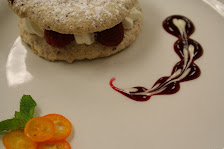Days 40, 41, and 42: Getting thinner.
The dough, of course; not me. Actually, before busting out the rolling pins, we began the week with some biscuits. It seems like a non sequitur from last week’s crust lessons, and after those colorful fifty-dollars-each tarts, a little like the shack among mansions. Biscuit dough, however, is made in much the same way as a pâte brisée; the fat is thoroughly rubbed into the dry ingredients until the mixture is mealy and uniform, and then the liquid is added. We used the classic White Lily flour, whose biscuits have graced the Southern table for as long as chitterlings (yes, that’s really how that’s spelled, can you believe it!?) and gravy. We also formed some scones by the same method. My team was lucky to have received the lemon-cornmeal scone recipe as an assignment. Several other teams were to prepare chocolate scones, and just as in the Great Donut Fiasco some weeks ago, they didn’t come out too hot. (Maybe they make the recipes that sound the best come out the worst in order to keep that fabled freshman twenty-seven at a level that wouldn’t beg too many lawsuits.) In any case, the biscuits were light and many-layered and flaky, and the scones had a delightful crispness from the cornmeal along with a refreshing hint of lemon.
Readying our pins and using a bit of dough we had made the week before, each team made a number of tiny tartlets. The whole process with this type of pastry, from weighing the ingredients to weighing yourself the morning after you’ve eaten too many of them, is the perfect training ground for the patience a pastry chef must learn. Each of these little desserts takes a fair bit of time to make: you form the dough, then chill, roll, mold, bake, and cool it; you make the pastry cream (or citrus curd, buttercream, or other filling), and cool it; you prepare miniscule slivers of whatever it is you’re planning to put on top. Then, finally, you’re up to filling and topping, the latter of which is best done with a pair of tweezers. After that, they’re ready for presentation and eating. And you watch the microcosmic fruit of so much labor disappear in one bite, or maybe one and a half if the eater is particularly demure. This teaches you to break the emotional bond with your products very quickly. (The value of which, as anyone who related to my sourdough disaster on Day 32 could tell you, cannot be overestimated.) That said, they were very elegant, and envisioning row upon row of them conjures images of the best-catered party any of us have been to.
We used a bit more of the same dough, rolled thin again, to make a Breton. This pastry, named for the Bretagne region of France, is basically a thinly veiled excuse to enclose candy in pastry and call it a dessert. We made a walnut caramel, placed it in a pastry shell, and then topped it with a second layer. Then, as if to further disguise its nature, we gave it a rustic fork design across the top. (No one in the country eats candy, everyone knows that.) Not that I’m complaining, mind you. It was awfully good.
From there we proceeded to the thinnest dough so far, the fabled Hungarian strudel. This dough is truly a marvel to behold. It begins as somewhat ordinary dough. You take a pound or so of it, and on a table covered with a clean cloth and amply floured, you begin to stretch it. You stretch and stretch, always using the backs of your hands, until the dough is thin enough to read through. (When I had read about strudel, I always thought it was just an expression to “read newsprint through” it, but seeing the clearly defined edges of my burn scar as the back of my hand stretched the dough toward me taught me otherwise.) What you’re left with at the end is a giant sheet (and I mean giant – ours was about six feet by eight feet), stretched so thin that you can see the gluten not only for the transparent membrane that it is, but also for its incredible extensibility if rested properly. After all the oohs and aahs had died down, we brushed the whole sheet with butter, strew breadcrumbs across it, and added our filling. I had chosen apple for our team, being somewhat the classicist but also wishing to avoid things like those mid-winter plums I’m always going on about. Then, the three of us lifting the tablecloth gingerly, gently, and in perfect concert, we began to roll up this monster of a confection. When we had finally rolled the entire thing, we divided it into three pieces, each of which could still be called large. The final product was everything you could hope for in a strudel – thin, flaky layers of crisp pastry enrobing a lightly sweet and mildly spiced fruit filling, the whole of which simply melted into oblivion on the palate. Even given its superlative eating qualities, it’s understandable why making strudel this traditional way is somewhat a dying art. Not only is it labor-intensive, but it requires the undivided attention of at least two, and preferably three people to pull it off properly. There are tales of some people who can make this alone, which I’m sure there are.
Just nobody I know.
Thursday, March 1, 2007
Subscribe to:
Post Comments (Atom)































































1 comment:
The food is gorgeous. The color of the raspberry souflee - wow!
Especially this one, what a combo:
orange curd with candied orange rind, ganache, and a gold leaf-wrapped hazelnut
Thanks for the link & best wishes to you.
Best,
Anita
Post a Comment